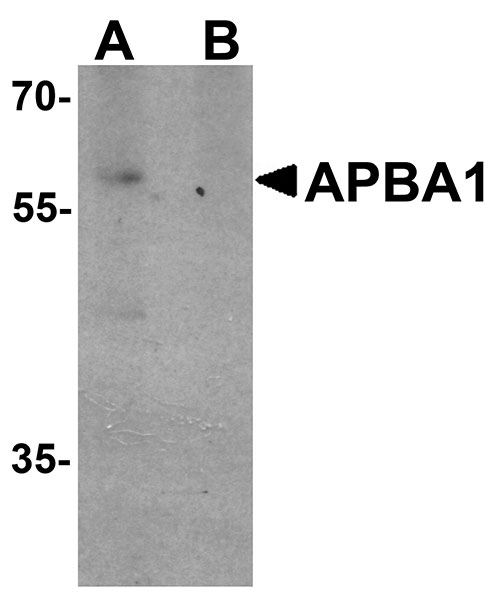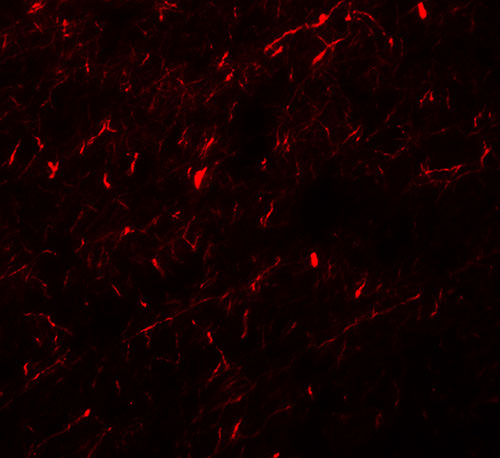APBA1 Antibody
- SPECIFICATION
- CITATIONS
- PROTOCOLS
- BACKGROUND

Application
| WB, IF, E |
|---|---|
| Primary Accession | Q02410 |
| Other Accession | NP_001154, 22035548 |
| Reactivity | Human, Mouse, Rat |
| Host | Rabbit |
| Clonality | Polyclonal |
| Isotype | IgG |
| Calculated MW | 92 kDa |
| Application Notes | APBA1 antibody can be used for detection of APBA1 by Western blot at 0.5 µg/mL. For immunofluorescence start at 20 µg/mL. |
| Gene ID | 320 |
|---|---|
| Target/Specificity | APBA1; At least two alternatively spliced isoforms are known to exist; this antibody will detect both isoforms. This antibody is predicted to not cross-react with other APBA proteins. |
| Reconstitution & Storage | APBA1 antibody can be stored at 4℃ for three months and -20℃, stable for up to one year. As with all antibodies care should be taken to avoid repeated freeze thaw cycles. Antibodies should not be exposed to prolonged high temperatures. |
| Precautions | APBA1 Antibody is for research use only and not for use in diagnostic or therapeutic procedures. |
| Name | APBA1 |
|---|---|
| Synonyms | MINT1, X11 |
| Function | Putative function in synaptic vesicle exocytosis by binding to Munc18-1, an essential component of the synaptic vesicle exocytotic machinery. May modulate processing of the amyloid-beta precursor protein (APP) and hence formation of APP-beta. Component of the LIN-10- LIN-2-LIN-7 complex, which associates with the motor protein KIF17 to transport vesicles containing N-methyl-D-aspartate (NMDA) receptor subunit NR2B along microtubules (By similarity). |
| Cellular Location | Cytoplasm. Cytoplasm, perinuclear region. Nucleus. Note=Only about 5% of the protein is located in the nucleus |
| Tissue Location | Brain and spinal cord. Isoform 2 is expressed in testis and brain, but not detected in lung, liver or spleen |

Thousands of laboratories across the world have published research that depended on the performance of antibodies from Abcepta to advance their research. Check out links to articles that cite our products in major peer-reviewed journals, organized by research category.
info@abcepta.com, and receive a free "I Love Antibodies" mug.
Provided below are standard protocols that you may find useful for product applications.
Background
APBA1 Antibody: The Amyloid beta 4 (A4) precursor protein-binding family A member 1 (APBA1) is a member of the X11 protein family and a neuronal adapter protein that interacts with the Alzheimer's disease amyloid precursor protein (APP). APBA1 stabilizes APP and inhibits production of proteolytic APP fragments including the Aβ peptide that is deposited in the brains of Alzheimer's disease patients. It is thought to be involved in signal transduction processes and is a putative vesicular trafficking protein in the brain that can form a complex with the potential to couple synaptic vesicle exocytosis to neuronal cell adhesion. APBA1 can also bind to CASK, a multidomain scaffolding protein involved in brain development and synapse formation.
References
Borg JP, Ooi J, Levy E, et al. The phosphotyrosine interaction domains of X11 and FE65 bind to distinct sites on the YENPTY motif of amyloid precursor protein. Mol. Cell. Biol. 1996; 16:6229-41.
Mueller HT, Borg JP, Margolis B, et al. Modulation of amyloid precursor protein metabolism by X11alpha/Mint1. A deletion analysis of protein-protein interaction domains. J. Biol. Chem. 2000; 275:39302-6.
Maximov A, Sudhof TC, and Bezprozvanny I. Association of neuronal calcium channels with modular adaptor proteins. J. Biol. Chem. 1999; 274:24453-6
Stafford RL, Ear J, Knight MJ, et al. The molecular basis of the Caskin1 and Mint1 interaction with CASK. J. Mol. Biol. 2011; 412:3-13.
If you have used an Abcepta product and would like to share how it has performed, please click on the "Submit Review" button and provide the requested information. Our staff will examine and post your review and contact you if needed.
If you have any additional inquiries please email technical services at tech@abcepta.com.













 Foundational characteristics of cancer include proliferation, angiogenesis, migration, evasion of apoptosis, and cellular immortality. Find key markers for these cellular processes and antibodies to detect them.
Foundational characteristics of cancer include proliferation, angiogenesis, migration, evasion of apoptosis, and cellular immortality. Find key markers for these cellular processes and antibodies to detect them. The SUMOplot™ Analysis Program predicts and scores sumoylation sites in your protein. SUMOylation is a post-translational modification involved in various cellular processes, such as nuclear-cytosolic transport, transcriptional regulation, apoptosis, protein stability, response to stress, and progression through the cell cycle.
The SUMOplot™ Analysis Program predicts and scores sumoylation sites in your protein. SUMOylation is a post-translational modification involved in various cellular processes, such as nuclear-cytosolic transport, transcriptional regulation, apoptosis, protein stability, response to stress, and progression through the cell cycle. The Autophagy Receptor Motif Plotter predicts and scores autophagy receptor binding sites in your protein. Identifying proteins connected to this pathway is critical to understanding the role of autophagy in physiological as well as pathological processes such as development, differentiation, neurodegenerative diseases, stress, infection, and cancer.
The Autophagy Receptor Motif Plotter predicts and scores autophagy receptor binding sites in your protein. Identifying proteins connected to this pathway is critical to understanding the role of autophagy in physiological as well as pathological processes such as development, differentiation, neurodegenerative diseases, stress, infection, and cancer.



